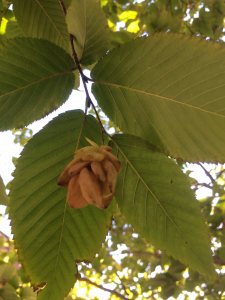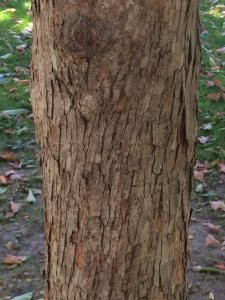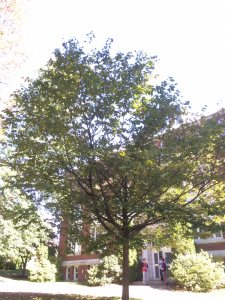Eastern Hophornbeam
Ostrya virginiana | Family: Betulaceae
Submission: Sammy Purnell ‘18
Leaves – similar to yellow birch (B. alleghaniensis), but secondary veins may branch.
Twigs – slender.
Buds – ovoid with scales striated longitudinally.
Fruits – nutlets borne in a papery sac suspended in strobiles resembling clusters of hops, hence the alternate name, Hophornbeam.
Bark – smooth and reddish-brown when young; later breaking into thin, shaggy plates that give it a characteristic shreddy appearance.
Natural History:
Eastern hophornbeam (Ostrya virginiana), is also referred to as ironwood or leverwood. It is a small to medium-sized tree in form, and it typically reaches between 30 to 50 feet in height. While younger trees have an ovate to pyramidal shape, older trees tend to be rounded and exhibit more irregular branching patterns. For a healthy younger tree, the branching is upright and spreading.
 The buds and catkins of eastern hophornbeam are an important winter food source for the ruffed grouse bird, with the nuts being a secondary food in the fall. It is also a preferred food source for sharp-tailed grouse and wild turkey, and is eaten by bobwhite, red and grey squirrels, cottontails, white-tailed deer, ring-necked pheasant, purple finch, rose-breasted grosbeak, and downy woodpeckers. Eastern hophornbeam is particularly prone to disease and rot in the trunk caused by the fungal pathogens, but is considered to be basically free of insect diseases.
The buds and catkins of eastern hophornbeam are an important winter food source for the ruffed grouse bird, with the nuts being a secondary food in the fall. It is also a preferred food source for sharp-tailed grouse and wild turkey, and is eaten by bobwhite, red and grey squirrels, cottontails, white-tailed deer, ring-necked pheasant, purple finch, rose-breasted grosbeak, and downy woodpeckers. Eastern hophornbeam is particularly prone to disease and rot in the trunk caused by the fungal pathogens, but is considered to be basically free of insect diseases.
 The wood of eastern hophornbeam is very close grained, strong, heavy, and exceedingly hard. It is used to make tool handles, wedges for directional felling of trees, and firewood, although it is incredibly difficult to cut down. While eastern hophornbeam is not large enough for the commercial lumber industry, it is still used locally, and makes an attractive landscape tree. The bark and inner wood of eastern hophornbeam was used for medicinal purposes by Native Americans to treat toothaches, sore muscles, coughs, and other ailments.
The wood of eastern hophornbeam is very close grained, strong, heavy, and exceedingly hard. It is used to make tool handles, wedges for directional felling of trees, and firewood, although it is incredibly difficult to cut down. While eastern hophornbeam is not large enough for the commercial lumber industry, it is still used locally, and makes an attractive landscape tree. The bark and inner wood of eastern hophornbeam was used for medicinal purposes by Native Americans to treat toothaches, sore muscles, coughs, and other ailments.
References:
Brockman, C.F. Trees of North America: A Guide to Field Identification. Revised Edition. Western Pub. Co., Inc. 280pp.
Elias, T.S. 1980. The Complete Trees of North America Field Guide and Natural History. Van Nostrand Reinhold Co., N.Y. 948pp.
Metzger, F.T. “Eastern Hophornbeam.” Silvics of North America.
Harlow, W.M., Harrar, E.S., Hardin, J.W. and White, F.M. 1991. Textbook of Dendrology. McGraw-Hill Inc., N.Y. 501pp.
Maine Forest Service. “Eastern Hophornbeam.” Forest Trees of Maine. 14th ed. Augusta, Maine: Maine Forest Service, 2008.
Petrides, G.A. 1972, A Field Guide to Trees and Shrubs. 2nd edition. Houghton Mifflin Co., Boston. 428pp.
Plant Database. “Ostrya Virginiana, American Hophornbeam, Ironwood Betulaceae.” University of Connecticut.
Preston, R.J., Jr. 1989. North American Trees. 4th edition. Iowa State Univ. Press. Ames. 407pp.
Shane, J. 2004. Dendrology Handbook, University of Vermont, Unpublished.
